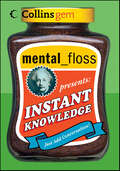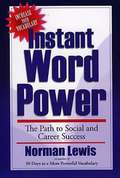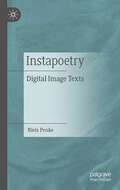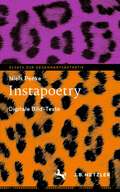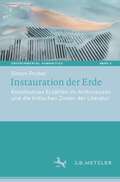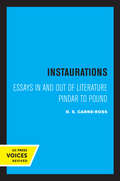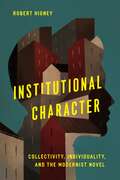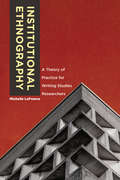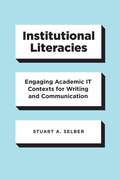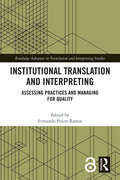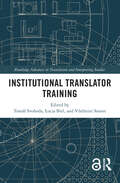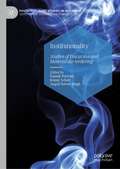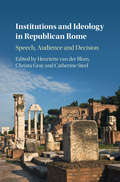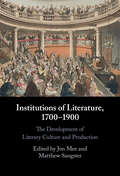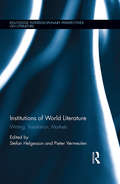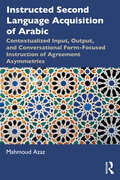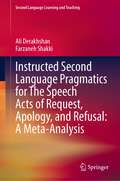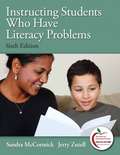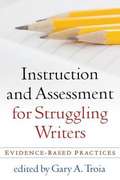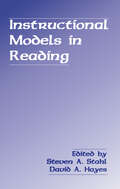- Table View
- List View
Instant Knowledge (Collins Gem)
by Editors of Mental FlossMental_floss is proud to present a full-bodied jolt of inspiration for thirsty minds on the go. Blended with titillating facts, startling revelations, and head-scratching theories collected from around the world, Instant Knowledge will jumpstart riveting exchanges at cocktail parties, the watercooler, or any powwow. To experience the clean, rich flavor at home, just tear into a topic of your choice, and add conversation. It's that simple!
Instant Word Power
by Norman LewisThis rapid vocabulary builder created by Norman Lewis is a foolproof method of increasing your vocabulary. Learn the derivation and meaning of thousands of words.
Instapoetry: Digital Image Texts
by Niels PenkeInstapoetry is one of the most popular literary phenomena of our time. In just a few years, millions of short to ultra-short texts have been published and shared on Instagram. In the battle for attention with countless other texts, the mechanisms of the platform and the usage routines of the users have to be served. The external pressure on literary production is immense. The book explains the production strategies and reception procedures of Instapoetry, explains its development and locates its significance - somewhere between the last stage of decay and the future of poetry.
Instapoetry: Digitale Bild-Texte (Essays zur Gegenwartsästhetik)
by Niels PenkeInstapoetry zählt zu den populärsten literarischen Phänomenen der Gegenwart. In wenigen Jahren sind Millionen von kurzen bis ultra-kurzen Texten auf Instagram publiziert und geteilt worden. Im Kampf um Aufmerksamkeit mit unzähligen anderen Texten müssen die Mechanismen der Plattform und die Nutzungsroutinen der User bedient werden. Der äußere Druck auf die literarische Produktion ist immens. Das Buch erklärt die Produktionsstrategien und Rezeptionsverfahren von Instapoetry, erläutert ihre Entwicklung und verortet ihre Bedeutung – irgendwo zwischen letzter Verfallsstufe und Zukunft der Lyrik.
Instauration der Erde: Konstitutives Erzählen im Anthropozän und die kritischen Zonen der Literatur (Environmental Humanities #2)
by Simon ProbstMit dem Anthropozän wird oft das Entstehen einer planetaren Universalität und die ‚Wiederkehr der großen Erzählungen‘ verknüpft. Die Verflechtungen von Menschen und Erde werden hier zur Grundlage kultureller Selbstverständigung. Das Buch untersucht strukturelle Merkmale und Problemkonstellationen dieser erdgebundenen konstitutiven Erzählungen. Wie können sie globale Ungleichheiten berücksichtigen? Wie lassen sie die Erde und andere Spezies zu Wort kommen? Inwiefern sind diese Erzählungen selbst planetare Kräfte? Und: Wie kann das Eigenwissen der Literatur unseren Blick auf die Erde erweitern? Diese Fragen werden im Dialog von Wissenschaft und Literatur untersucht. Eingehende Lektüren verbinden kanonische Texten des Anthropozän-Diskurses (z.B. Dipesh Chakrabarty, Donna Haraway, Bruno Latour und Isabelle Stengers) mit literarischen Stimmen (Ursula K. Le Guin, Daniel Falb, Christoph Ransmayr).
Instaurations: Essays in and out of Literature Pindar to Pound
by D. S. Carne-RossThis book presents a sequence of six related studies of poets from classical antiquity to the present (Pindar and Sophocles at one end, Pound at the other, with Dante somewhere in the middle). This group of literary essays is framed by two more general papers showing how the texts can reach out into our society and into the lives we lead there--and can question the lives we lead. the opening paper argues for a way of reading (as rigorous as those honored in the academy but directed to different ends) that would restore to literature its old didactic function, and the final paper searches for a place where such a reading might be possible--a way of reading that would also be a way of living. Literature matters, more than it ever has before, because it is the strongest remaining witness to much that mankind has always known but is now in danger of losing. It can tell us things about human being and about nature and about "the gods" that we have forgotten. But it can do so only if we read very hard, hence the body of this book consists of close textual studies of poets old and new that will be of value even to those who are disturbed by the author's views on the role of literature today. The word "instauration" means renewal and is also intended to point to a conception of poetry as celebration. Beyond that, it means a founding, the sense Bacon had in mind when he called his program for the advancement of natural science Instauratio magna. Three and half centuries later, we may be coming to the end of the great movement at whose beginnings Bacon stood. If so, the question that faces us all is, What comes next, what new founding is possible? This books looks forward to another instauration: One to which poetic thinking will have more contribute. This title is part of UC Press's Voices Revived program, which commemorates University of California Press's mission to seek out and cultivate the brightest minds and give them voice, reach, and impact. Drawing on a backlist dating to 1893, Voices Revived makes high-quality, peer-reviewed scholarship accessible once again using print-on-demand technology. This title was originally published in 1979.
Institutional Character: Collectivity, Individuality, and the Modernist Novel (Cultural Frames, Framing Culture)
by Robert HigneyHow do our institutions shape us, and how do we shape them? From the late nineteenth-century era of high imperialism to the rise of the British welfare state in the mid-twentieth century, the concept of the institution was interrogated and rethought in literary and intellectual culture. In Institutional Character, Robert Higney investigates the role of the modernist novel in this reevaluation, revealing how for a diverse array of modernist writers, character became an attribute of the institutions of the state, international trade, communication and media, labor, education, public health, the military, law, and beyond.In readings of figures from the works of E. M. Forster, Joseph Conrad, and Virginia Woolf to Mulk Raj Anand, Elizabeth Bowen, and Zadie Smith, Higney presents a new history of character in modernist writing. He simultaneously tracks how writers themselves turned to the techniques of fiction to help secure a place in the postwar institutions of literary culture. In these narratives—addressing imperial administrations, global financial competition, women’s entry into the professions, colonial nationalism, and wartime espionage—we are shown the generative power of institutions in preserving the past, designing the present, and engineering the future, and the constitutive involvement of individuals in collective life.
Institutional Ethnography: A Theory of Practice for Writing Studies Researchers
by Michelle LaFranceA form of critical ethnography introduced to the social sciences in the late 1990s, institutional ethnography uncovers how things happen within institutional sites, providing a new and flexible tool for the study of how “work” is co-constituted within sites of writing and writing instruction. The study of work and work processes reveals how institutional discourse, social relations, and norms of professional practice coordinate what people do across time and sites of writing. Adoption of IE offers finely grained understandings of how our participation in the work of writing, writing instruction, and sites of writing gives material face to the institutions that govern the social world. In this book, Michelle LaFrance introduces the theories, rhetorical frames, and methods that ground and animate institutional ethnography. Three case studies illustrate key aspects of the methodology in action, tracing the work of writing assignment design in a linked gateway course, the ways annual reviews coordinate the work of faculty and writing center administrators and staff, and how the key term “information literacy” socially organizes teaching in a first-year English program. Through these explorations of the practice of ethnography within sites of writing and writing instruction, LaFrance shows that IE is a methodology keenly attuned to the material relations and conditions of work in twenty-first-century writing studies contexts, ideal for both practiced and novice ethnographers who seek to understand the actualities of social organization and lived experience in the sites they study. Institutional Ethnography expands the field’s repertoire of research methodologies and offers the grounding necessary for work with the IE framework. It will be invaluable to writing researchers and students and scholars of writing studies across the spectrum—composition and rhetoric, literacy studies, and education—as well as those working in fields such as sociology and cultural studies.
Institutional Literacies: Engaging Academic IT Contexts for Writing and Communication
by Stuart A. SelberInformation technologies have become an integral part of writing and communication courses, shaping the ways students and teachers think about and do their work. But, too often, teachers and other educational stakeholders take a passive or simply reactive role in institutional approaches to technologies, and this means they are missing out on the chance to make positive changes in their departments and on campus. Institutional Literacies argues that writing and communication teachers and program directors should collaborate more closely and engage more deeply with IT staff as technology projects are planned, implemented, and expanded. Teachers need to both analyze how their institutions approach information technologies and intervene in productive ways as active university citizens with relevant expertise. To help them do so, the book offers a three-part heuristic, reflecting the reality that academic IT units are complex and multilayered, with historical, spatial, and textual dimensions. It discusses six ways teachers can intervene in the academic IT work of their own institutions: maintaining awareness, using systems and services, mediating for audiences, participating as user advocates, working as designers, and partnering as researchers. With these strategies in hand, educators can be proactive in helping institutional IT approaches align with the professional values and practices of writing and communication programs.
Institutional Translation and Interpreting: Assessing Practices and Managing for Quality (Routledge Advances in Translation and Interpreting Studies)
by Fernando Prieto RamosThis collection brings together new insights around current translation and interpreting practices in national and supranational settings. The book illustrates the importance of further reflection on issues around quality and assessment, given the increased development of resources for translators and interpreters. The first part of the volume focuses on these issues as embodied in case studies from a range of national and regional contexts, including Finland, Switzerland, Italy, Spain and the United States. The second part takes a broader perspective to look at best practices and questions of quality through the lens of international bodies and organizations and the shifting roles of translation and interpreting practitioners in working to manage these issues. Taken together, this collection demonstrates the relevance of critically examining processes, competences and products in current institutional translation and interpreting settings at the national and supranational levels, paving the way for further research and quality assurance strategies in the field.
Institutional Translator Training (Routledge Advances in Translation and Interpreting Studies)
by Tomáš Svoboda, Łucja Biel, and Vilelmini SosoniThis collection surveys the translator training landscape in international organizations on a global scale, offering a state-of-the-art view on institutional translator training research and practical takeaways for stakeholders. The volume’s focus on training brings a unique perspective to existing research on institutional translation, which has tended to single out such themes as agency, professionalism, and quality. The book is divided into three sections, with the first outlining the competences required of institutional translators, the second exploring training practices at the university level and "on the job", for novices and professionals, across a range of settings, and the third providing a synthesis of the above. Contributions draw on findings from studies in both institutional desiderata and existing training programmes from diverse geographic contexts towards situating the discussion through a global lens. In linking together competences and training practices, the book enhances collective knowledge of institutional translation and provides valuable insights for universities and institutions that work with translators on both international and national scales. This book will be key reading for scholars in translation studies, particularly those interested in institutional translation and translator training, as well as active professionals.
Institutionality: Studies of Discursive and Material (Re-)ordering (Postdisciplinary Studies in Discourse)
by Yannik Porsché Ronny Scholz Jaspal Naveel SinghThis edited book brings together humanities and social sciences scholars from the various disciplines at the nexus of discourse studies and ethnography to reflect on questions of institutional practices and their political concerns. Institutional order plays an important role in structuring power relations in society. Yet, contrary to common understandings of structure, institutional orders are far from fixed or stable. They constantly change, and they are resisted and reimagined by social actors. The 20 studies collected in this edited volume develop the notion of institutionality as an overarching perspective to explore how institutional actors and institutional practices order and reorder power in societies across the globe. Thereby the chapters pay special attention to the fluidity, volatility, fragility, and ambiguity of order, and consequently to its claims to authority. Employing a broad range of discourse analytic and ethnographic methodologies, the studies show how institutions are discursively and materially constructed, defined, represented and how they are made relevant and become powerful – or how they are resisted, transformed or lose significance – in interaction. Readers will obtain nuanced insights into ways in which differently positioned social actors engage in struggles about how institutions can be imagined and enacted across several domains, such as workplace interactions, architecture, mass-media representations or organisational publicity. This book will be of interest to readers in Applied Linguistics, Discourse and Society, Critical Discourse Analysis, Political Theory and Communication Studies.
Institutions and Ideology in Republican Rome: Speech, Audience And Decision
by Catherine Steel Henriette Van Der Blom Christa GrayThis volume brings together a distinguished international group of researchers to explore public speech in Republican Rome in its institutional and ideological contexts. The focus throughout is on the interaction between argument, speaker, delivery and action. The chapters consider how speeches acted alongside other factors - such as the identity of the speaker, his alliances, the deployment of invective against opponents, physical location and appearance of other members of the audience, and non-rhetorical threats or incentives - to affect the beliefs and behaviour of the audience. <P><P>Together they offer a range of approaches to these issues and bring attention back to the content of public speech in Republican Rome as well as its form and occurrence. The book will be of interest not only to ancient historians, but also to those working on ancient oratory and to historians and political theorists working on public speech.<P> Offers a holistic and detailed picture of the dynamics and conditions behind world-changing events in Roman history.<P> Restores a focus on the content of public speech in Republican Rome, as well as its forms and occurrence.<P> All ancient languages are translated.
Institutions of Literature, 1700–1900
by Jon Mee Matthew SangsterThis collection provides students and researchers with a new and lively understanding of the role of institutions in the production, reception, and meaning of literature in the period 1700–1900. The period saw a fundamental transition from a patronage system to a marketplace in which institutions played an important mediating role between writers and readers, a shift with consequences that continue to resonate today. Often producers themselves, institutions processed and claimed authority over a variety of cultural domains that never simply tessellated into any unified system. The collection's primary concerns are British and imperial environments, with a comparative German case study, but it offers encouragement for its approaches to be taken up in a variety of other cultural contexts. From the Post Office to museums, from bricks and mortar to less tangible institutions like authorship and genre, this collection opens up a new field for literary studies.
Institutions of World Literature: Writing, Translation, Markets (Routledge Interdisciplinary Perspectives on Literature)
by Pieter Vermeulen Stefan HelgessonThis volume engages critically with the recent and ongoing consolidation of "world literature" as a paradigm of study. On the basis of an extended, active, and ultimately more literary sense of what it means to institute world literature, it views processes of institutionalization not as limitations, but as challenges to understand how literature may simultaneously function as an enabling and exclusionary world of its own. It starts from the observation that literature is never simply a given, but is always performatively and materially instituted by translators, publishers, academies and academics, critics, and readers, as well as authors themselves. This volume therefore substantiates, refines, as well as interrogates current approaches to world literature, such as those developed by David Damrosch, Pascale Casanova, and Emily Apter. Sections focus on the poetics of writers themselves, market dynamics, postcolonial negotiations of discrete archives of literature, and translation, engaging a range of related disciplines. The chapters contribute to a fresh understanding of how singular literary works become inserted in transnational systems and, conversely, how transnational and institutional dimensions of literature are inflected in literary works. Focusing its methodological and theoretical inquiries on a broad archive of texts spanning the triangle Europe-Latin America-Africa, the volume unsettles North America as the self-evident vantage of recent world literature debates. Because of the volume’s focus on dialogues between world literature and fields such as postcolonial studies, translation studies, book history, and transnational studies, it will be of interest to scholars and students in a range of areas.
Instructed Second Language Acquisition of Arabic: Contextualized Input, Output, and Conversational Form-Focused Instruction of Agreement Asymmetries
by Mahmoud AzazInstructed Second Language Acquisition of Arabic examines the acquisition of agreement asymmetries in the grammatical system of Arabic as a second/foreign language through the lens of instructed second language acquisition. The book explores how to improve the processes of L2 learning of Arabic using evidence-based classroom research. Before it does this, it characterizes the variable challenges that English L2 learners of Arabic face when they acquire four structural cases in Arabic grammar that entail agreement asymmetries. Using the pretest–posttest design, it examines the effects of four classroom interventions using quantitative and qualitative measures. In these interventions, form-based and meaning-based measures were used to reveal to what degree learners have developed explicit and implicit knowledge of these aspects of asymmetry. In the concluding chapter, the book provides focused and specific implications based on the results of the four studies. It provides theoretical implications that enrich the discussions of instructed second language Acquisition in Arabic and other languages more broadly. It also provides implications for teachers, curriculum designers, and textbook writers of Arabic. This book will be informative for Arabic applied linguists, researchers of Arabic SLA, Arabic instructors (at the K–12 and the college level), and Arabic program directors and coordinators. The book will also appeal to all SLA and ISLA researchers.
Instructed Second Language Pragmatics for The Speech Acts of Request, Apology, and Refusal: A Meta-Analysis (Second Language Learning and Teaching)
by Ali Derakhshan Farzaneh ShakkiPragmatic instruction has received momentous attention in Second Language Acquisition (SLA) over the last decades. In order to scrutinize the effectiveness of L2 instruction, meta-analyses are warranted; nonetheless, meta-analyses have been largely neglected, despite the fact that they provide a systematic explanation of the findings from the previous studies. Since meta-analysis is flourishing by leaps and bounds in each and every field, pragmatic studies are not the exception, and among miscellaneous constructs and units of analysis in pragmatics, the speech acts of request, apology, and refusal are investigated in this book. To bridge this gap, this book mainly presents the variables which can moderate the effectiveness of L2 instruction such as age, gender, proficiency, outcome measures, psycholinguistic features, research design, and treatment types. The first chapter of the book outlines the theoretical underpinnings of the study, accentuating the importance of conducting meta-analysis in this field of study. The second chapter elaborates on the empirical studies and a thorough review of the relevant research. The third chapter deals with the design of the study in which the inclusion and exclusion criteria, effect size calculation, coding of the variables, and reliability have been outlined while chapter four presents the obtained outcomes and results of the study. The last chapter describes the final remarks of the study, the limitations, implications, and the directions for future research in the field of pragmatics instruction.
Instructing Students Who Have Literacy Problems (6th edition)
by Jerry Zutell Sandra MccormickThis research-based book on assessment and instruction of struggling readers covers both assessment and instructional strategies and reflects a balanced view of literacy instruction. Four complete chapters on formal and informal assessment, plus chapters on instructional interventions, including reading instruction for special populations, allow professors the option of using the book for one inclusive course, or, using it across two courses where diagnosis and instruction are taught separately.
Instruction Giving in Online Language Lessons: A Multimodal (Inter)action Analysis (Routledge Focus on Applied Linguistics)
by Müge Satar Ciara R. WighamThis concise volume calls attention to the instruction-giving practices of language teachers in online environments, in particular videoconferencing, employing a Multimodal (Inter)action Analysis approach to explore the challenges, affordances, and pedagogical implications of teaching in these settings. The book examines the unique competences necessary for language teachers in multimodal synchronous online environments, which require mediating a mix of modes, including spoken language gaze, gesture, posture, and textual elements. Satar and Wigham’s innovative approach draws on Sigrid Norris’s work on Multimodal (Inter)action Analysis to examine variance in practices, combining in-depth micro-analytic analysis of mediation with a consideration of the modal density and complexity in the act of giving instructions. The volume shows how studying instruction giving can offer a better understanding of how online teachers mediate learning multimodally in electronic environments, but also research-informed guidance for practical implementation in the classroom. This book is a valuable resource for scholars in applied linguistics, language education, and language learning and teaching as well as practicing online language teachers. Full-size versions of all Figures, Extracts, and Tables are available in colour at https://doi.org/10.25405/data.ncl.20315142 Chapter 6 of this book is available for free in PDF format as Open Access from the individual product page at www.routledge.com. It has been made available under a Creative Commons Attribution-Non Commercial-No Derivatives 4.0 license.
Instruction Giving in Online Language Lessons: A Multimodal (Inter)action Analysis (Routledge Focus on Applied Linguistics)
by Müge Satar Ciara R. WighamThis concise volume calls attention to the instruction-giving practices of language teachers in online environments, in particular videoconferencing, employing a Multimodal (Inter)action Analysis approach to explore the challenges, affordances, and pedagogical implications of teaching in these settings.The book examines the unique competences necessary for language teachers in multimodal synchronous online environments, which require mediating a mix of modes, including spoken language gaze, gesture, posture, and textual elements. Satar and Wigham’s innovative approach draws on Sigrid Norris’s work on Multimodal (Inter)action Analysis to examine variance in practices, combining in-depth micro-analytic analysis of mediation with a consideration of the modal density and complexity in the act of giving instructions. The volume shows how studying instruction giving can offer a better understanding of how online teachers mediate learning multimodally in electronic environments, but also research-informed guidance for practical implementation in the classroom.This book is a valuable resource for scholars in applied linguistics, language education, and language learning and teaching as well as practicing online language teachers.Full-size versions of all Figures, Extracts, and Tables are available in colour at https://doi.org/10.25405/data.ncl.20315142 Chapter 6 of this book is available for free in PDF format as Open Access from the individual product page at www.routledge.com. It has been made available under a Creative Commons Attribution-Non Commercial-No Derivatives 4.0 license.
Instruction Manual for Braille Transcribing
by Constance Risjord Library Of Congress National Library Service for the Blind Physically Handicapped StaffThe courses leading to certification as a braille transcriber or proofreader have been administered by the National Federation of the Blind (NFB) under a contract with and on behalf of the National Library Service for the Blind and Physically Handicapped, Library of Congress (NLS).
Instruction and Assessment for Struggling Writers
by Gary TroiaThis unique book focuses on how to provide effective instruction to K-12 students who find writing challenging, including English language learners and those with learning disabilities or language impairments. Prominent experts illuminate the nature of writing difficulties and offer practical suggestions for building students' skills at the word, sentence, and text levels. Topics include writing workshop instruction; strategies to support the writing process, motivation, and self-regulation; composing in the content areas; classroom technologies; spelling instruction for diverse learners; and assessment approaches. Every chapter is grounded in research and geared to the real-world needs of in-service and preservice teachers in general and special education settings.
Instructional Models in Reading
by Steven A. Stahl David A. HayesThis book started with a simple idea -- examine models of reading instruction that have emerged during the past 20 years. These models span a wide range of instruction representing a continuum from highly structured, task analytic instruction to child-centered and holistic instruction. Each model has its own epistemology or views on how "reading" and "instruction" are to be defined. The different epistemologies indicate different principles of instruction which, in turn, indicate different practices in the classroom. Each model is also supported by a different research base. In this volume, leading proponents of these different models discuss their ideas about reading instruction thereby encouraging readers to make their own comparisons and contrasts. The chapter authors seem to adopt the editors' eclectic approach--to some greater or lesser extent--incorporating aspects of other models into their instruction as they see other goals. Thus, models of reading instruction are complex. Complicating matters further is the fact that teachers hold their own models of reading, which may or may not be congruent with those discussed here. Although academically developed models influence college preservice and in-service instruction, teachers' own models of reading filter the information that they take from what they learn from these perspectives. By carefully examining these variables, this book makes a firm contribution toward disciplined inquiry into what it means to teach reading.
